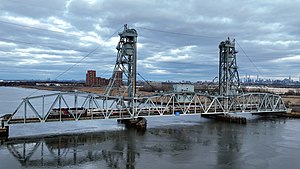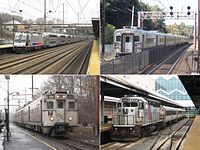
The Delaware, Lackawanna and Western Railroad, also known as the DL&W or Lackawanna Railroad, was a U.S. Class 1 railroad that connected Buffalo, New York, and Hoboken, New Jersey, and by ferry with New York City, a distance of 395 miles (636 km). The railroad was incorporated in Pennsylvania in 1853, and created primarily to provide a means of transport of anthracite coal from the Coal Region in Northeast Pennsylvania to large coal markets in New York City. The railroad gradually expanded both east and west, and eventually linked Buffalo with New York City.

The Main Line is a commuter rail line owned and operated by New Jersey Transit running from Suffern, New York to Hoboken, New Jersey, in the United States. It runs daily commuter service and was once the north–south main line of the Erie Railroad. It is colored yellow on NJ Transit system maps, and its symbol is a water wheel.

NJ Transit Rail Operations is the rail division of NJ Transit. It operates commuter rail service in New Jersey, with most service centered on transportation to and from New York City, Hoboken, and Newark. NJ Transit also operates rail service in Orange and Rockland counties in New York under contract to Metro-North Railroad. The commuter rail lines saw 57,179,000 riders in 2023, making it the third-busiest commuter railroad in North America and the longest commuter rail system in North America by route length.

A moveable bridge, or movable bridge, is a bridge that moves to allow passage for boats or barges. In American English, the term is synonymous with drawbridge, and the latter is the common term, but drawbridge can be limited to the narrower, historical definition used in some other forms of English, in which drawbridge refers to only a specific type of moveable bridge often found in castles.

The Lackawanna Cut-Off was a rail line built by the Delaware, Lackawanna and Western Railroad (DL&W). Constructed from 1908 to 1911, the line was part of a 396-mile (637 km) main line between Hoboken, New Jersey, and Buffalo, New York. It ran west for 28.45 miles (45.79 km) from Port Morris Junction in Port Morris, New Jersey, near the south end of Lake Hopatcong about 45 miles (72 km) west-northwest of New York City, to Slateford Junction in Slateford, Pennsylvania near the Delaware Water Gap.

The Delair Bridge is a railroad bridge with a vertical-lift section that crosses the Delaware River between Philadelphia, Pennsylvania, and Pennsauken Township, New Jersey, just south of the Betsy Ross Bridge. The two-track bridge is part of Conrail Shared Assets Operations and is jointly used by Norfolk Southern Railway and CSX Transportation freight trains, as well as by the New Jersey Transit Atlantic City Line service.

Roseville Avenue was a transfer station on New Jersey Transit's Morris & Essex Lines in Newark, New Jersey, United States. The station was built by the Delaware, Lackawanna and Western Railroad in 1903 as part of a project to lower the tracks below the road surface to eliminate grade crossings. It serviced Newark's Roseville neighborhood. It once had two tracks on the Lackawanna mainline and two low-wall platforms, with an additional platform along the Montclair Branch. The station remained in service during most of the 20th century, until New Jersey Transit closed the station on September 16, 1984.
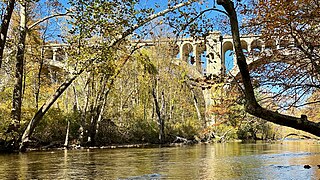
The Paulinskill Viaduct, also known as the Hainesburg Viaduct, is a reinforced concrete railroad bridge that crosses the Paulins Kill in Knowlton Township, New Jersey. When completed in 1910, it was the largest reinforced concrete structure in the world.
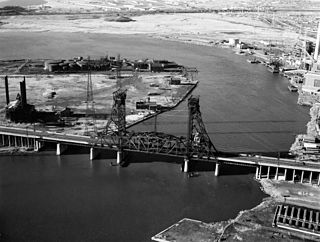
The Lower Hack Lift is a lift bridge carrying the New Jersey Transit Morristown Line across the Hackensack River at mile 3.4, Jersey City, New Jersey.
The Boonton Branch refers to the railroad line in New Jersey that was completed in 1870 and ran 34 miles (54.8 km) from Hoboken to East Dover Junction as part of the Morris & Essex Railroad (M&E). Although the branch hosted commuter trains, the line was primarily built as a freight bypass line. The term "branch", therefore, is somewhat of a misnomer since the Boonton Branch was built to higher mainline standards than the Morristown Line, the line that it bypassed. As a result, the Boonton Branch better meets the definition of a "cut-off" rather than a branch. Some of the towns that the Boonton Branch passed through included Lyndhurst, Passaic, Clifton, Paterson, Wayne, Lincoln Park, Mountain Lakes, and its namesake, Boonton.

The Newark Drawbridge, also known as the Morristown Line Bridge, is a railroad bridge on the Passaic River between Newark and Harrison, New Jersey. The swing bridge is the 11th bridge from the river's mouth at Newark Bay and is 5.85 miles (9.41 km) upstream from it. Opened in 1903, it is owned and operated by New Jersey Transit.

The Lyndhurst Draw is a railroad bridge crossing the Passaic River between Clifton and Lyndhurst in northeastern New Jersey. Built in 1903, it is owned and operated by New Jersey Transit Rail Operations (NJT).
The Hackensack Drawbridge was a double-track railroad movable bridge across the mouth of the Hackensack River between Jersey City and Kearny, New Jersey. It was operational until 1946, when a steamship crashed into it.

The Court Street Bridge, also known as the Harold J. Dillard Memorial Bridge, is a vehicular movable bridge crossing the Hackensack River between Hackensack and Bogota in Bergen County, New Jersey, which owns it. Located 16.2 miles (26.1 km) from the river mouth at Newark Bay, the swing bridge, which opened in 1908 and underwent major rehabilitation in 2010–2012, is the most-upstream bridge on the river required by federal regulations to open on request.

Greendell is one of three original railway stations built by the Delaware, Lackawanna & Western Railroad (DL&W) along its Lackawanna Cut-Off line in northwestern New Jersey. The station, which still stands in Green Township at milepost 57.61 on the Cut-Off, began operations on December 23, 1911, one day before the line itself.

The Nicholson Cutoff is a rail line segment of the Sunbury Line rail line and formerly a rail line segment of the Delaware, Lackawanna and Western Railroad main line and the Delaware and Hudson Railway South Line. The Nicholson Cutoff and the rest of the Sunbury Line is owned by Norfolk Southern Railway.
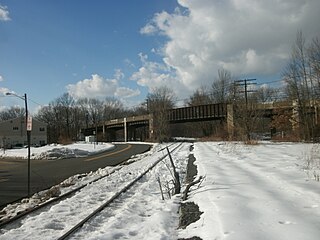
Mountain View was a station on the Boonton Branch of the Delaware, Lackawanna and Western Railroad. Located in the Mountain View section of Wayne Township, New Jersey, the station was at the Parish Drive bridge over the tracks. The station was 20.8 miles (33.5 km) away from its terminus at Hoboken Terminal on the shores of the Hudson River, where connections would be made to New York City via ferry and the Hudson and Manhattan Railroad. The western terminus. Denville, was 12.8 miles (20.6 km) away, where connections with the Morris and Essex Railroad were available. Just west of the station was Mountain View junction, where a connection to the Erie Railroad's New York and Greenwood Lake Railway was made.
